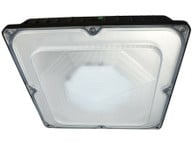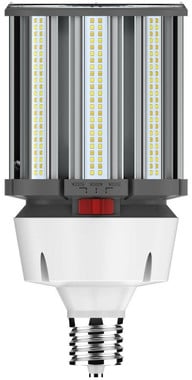LED Warehouse High Bay Lighting
LED Warehouse High Bay Lighting
Correct lighting is an essential component for any industrial setting, especially for warehouses where accuracy and safety are key. As the focus on energy efficiency intensifies, LED Warehouse High Bay Lighting is increasingly becoming the go-to choice for smart businesses everywhere.
At Superior Lighting, we offer a range of quality, energy-efficient lighting designed for the specific needs of today’s warehouses. Keep reading to discover how the right lighting fixtures can illuminate your warehouse while saving on energy and reducing your overhead costs.
Filter Products
Understanding Warehouse Lighting Needs
A warehouse is a complex environment requiring specialized lighting. Effective warehouse lighting should meet several key criteria: scale, brightness, durability, and coverage. Scale and coverage refer to the size of the space you’re illuminating. Warehouses are large spaces that need evenly distributed lighting, so no corner is left in the dark.
Brightness, often measured in lumens, is also essential because adequate light is crucial for tasks like reading labels, operating machinery, and ensuring the safety of your workforce. Traditional light sources, such as incandescent or fluorescent lighting fixtures, often struggle to meet these needs. They either consume too much power or require frequent replacements, leading to increased operational costs and maintenance hassles.
Moreover, traditional lights can contribute to visual fatigue for your employees, affecting both productivity and safety. Simply put, outdated light fixtures are a dim idea when it comes to meeting modern warehouse requirements.
Why LED Warehouse High Bay Lighting is the Ideal Choice
Energy Efficiency
The push for sustainability and operational efficiency is making LED warehouse lighting a critical choice for warehouses. One of the most compelling benefits of high bay lights is its energy efficiency. Unlike traditional light sources, which waste a lot of energy as heat, LEDs convert nearly 95% of the energy they consume into light.
This optimized energy consumption not only helps reduce your electricity bills but also makes a significant impact on your carbon footprint. When you consider the size of a warehouse, these savings can be quite substantial over time.
Longevity
Another feature that sets LED lighting apart is its longevity. The average LED light can last up to 50,000 hours or more, depending on the brand and usage, drastically outliving traditional lighting options. This means fewer replacements and less time spent on maintenance, allowing you to focus on what really matters—running your warehouse efficiently.
Quality
The quality of light emitted by LEDs is another major advantage. LED Warehouse High Bay Lighting provides consistent, bright illumination without the flickering or dimming that often occurs with older light technologies. The better the light quality, the safer and more productive your warehouse becomes. Better visibility can reduce accidents and help employees complete their tasks more efficiently.
Flexibility
Finally, LED lights are far more flexible when it comes to design and functionality. From dimmable lights to integrated control systems, LEDs offer a range of features that can be tailored to suit the unique needs of a warehouse environment. With options like adjustable lens angles and color temperature controls, you can customize your lighting solution to fit the specific needs of different areas within your warehouse.
Types of LED Warehouse High Bay Lighting
There is no one-size-fits-all solution to lighting a warehouse or other large industrial space. The layout, height, and specific tasks performed in different areas can necessitate various types of lighting solutions. Here, we will outline the different LED High Bay lighting designs tailored to meet these specific needs.
Linear High Bays
Linear high bays are long, rectangular fixtures that provide bright, even light across a wide area. These are particularly effective for warehouses with shelving and long aisles. The linear design allows for consistent light distribution, making it easier for workers to identify items on shelves and move around safely. Because of their shape, they can be easily installed in a continuous line, providing an uninterrupted flow of light along the length of the space.
Round High Bays
Round high bays, often referred to as UFOs due to their round, saucer-like shape, are versatile and can be used in a variety of settings. They’re particularly well-suited for spaces with higher ceilings, as they project a strong, focused light downward.
The design allows for heat to be more efficiently dissipated, contributing to a longer lifespan for the unit. Their compact and unobtrusive design makes them a go-to choice for areas where aesthetics are a consideration alongside functionality.
Adjustable Lens High Bays
Adjustable lens high bays offer the flexibility to change the beam angle of the light, making them ideal for spaces that require targeted lighting. Whether you need focused light on a workstation or more diffused light to cover a broader area, these high bays give you the control to adjust as needed. This adaptability makes them particularly valuable in warehouses that have a mix of storage and workspaces.
Key Features to Look for in LED Warehouse High Bay Lighting
Choosing the right warehouse lighting is about more than just brightness and price. Here, we’ll examine the essential attributes that should inform your decision when picking the most efficient LED Warehouse High Bay light for your specific needs.
Luminous Efficacy
One of the first things to consider is the luminous efficacy of the lighting fixture, which is the light output per watt. This measures how efficiently a light source produces visible light, and it’s an excellent indicator of both performance and efficiency. A higher luminous efficacy means you’re getting more light while using less power, which will substantially lower your energy costs over time.
Color Temperature
The color temperature, measured in Kelvins (K), affects both the aesthetic and practical aspects of your warehouse lighting. Lower temperatures (around 2700K-3000K) produce warm, yellowish light, while higher temperatures (4000K-6000K) generate a cooler, bluish light. The latter is often preferred in warehouses because it tends to reduce eye strain and increase alertness among workers, contributing to both comfort and productivity.
Dimming and Controls
Having the ability to adjust brightness levels can be a significant asset in a warehouse setting. Dimming controls allow you to modify light output according to the specific tasks being performed, the time of day, or other requirements. Some advanced lighting systems can be integrated with smart control systems, allowing for remote adjustments and even automated settings based on sensors or time schedules.
Durability and Lifespan
Last but certainly not least, consider the durability of the light fixture, especially in a tough warehouse environment. Features like shatter-resistant lenses and a robust housing material can go a long way in extending the lifespan of your lighting fixtures. Furthermore, LEDs, in general, have a much longer lifespan compared to traditional lighting solutions, which means less frequent replacements and, consequently, lower maintenance costs.
Get Your Warehouse High Bay LEDs at Superior Lighting
Looking to make the switch to LED Warehouse High Bay Lighting? Superior Lighting is your trusted source for high-quality, energy-efficient lighting solutions designed to meet the unique needs of your warehouse or industrial facility.Contact our team today to find the right LED lighting solutions that will illuminate your warehouse while saving you money and energy in the long run.




























